The Best Solar Panels for Camping
A solar panel for camping can be an invaluable tool for outdoor enthusiasts, especially if you’re planning a camping trip in a remote area with no electrical hookup.
Videos by Outdoors
To use a solar panel, all you have to do is place the device under direct sunlight. It will then absorb the light and convert it into energy, which you can use to charge things like cell phones, cameras, and other electronic devices.
When we talk about solar panels for camping, we’re specifically referring to portable solar panels. Although they all function pretty much the same way, they vary in size.
Some solar panels are small enough to carry inside a backpack while others will fit conveniently inside a vehicle. The difference between a small portable solar panel and a large one is its power output. A larger solar panel can convert more energy per hour than a smaller one.
More often than not, people also ask if a power bank is a better option than a solar panel. The answer depends on the amount of time you plan on spending in the wilderness as well as the equipment you need to recharge.
For example, if all you’re planning to charge is a cell phone, a power bank is better for short camping trips while a portable solar panel is better for multi-day hikes or adventures.
We’ve compiled a list of the six best solar panels for camping. We rated the options based on their performance, power output, features, and size. Although we named the Anker Solix PS30 Solar Panel as the best overall, we wanted to provide a variety of other solar panels for backpacking and price.
The Best Solar Panels for Camping
Best Overall: Anker Solix PS30 Solar Panel
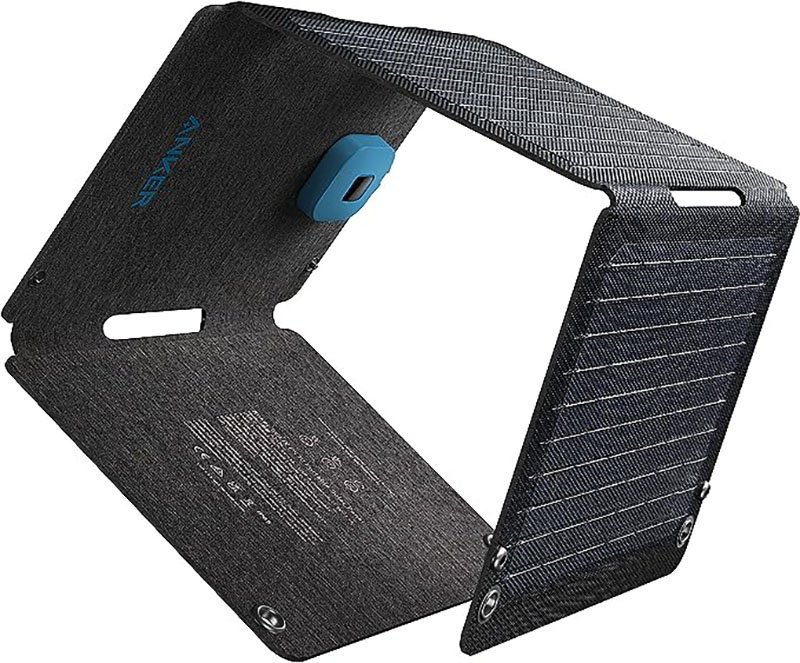
For the best overall, we picked the Anker 30W Solar Panel because it packs up to about the width and length of a sheet of paper and offers lots of power output.
With a 30-watt power output, the Anker solar panel can charge small electronic devices like a cell phone or tablet in less than four hours. Also, it has two USB ports (USB A and USB C) and it’s extremely durable with an IP65 weather-resistant protection rating.
At 2 pounds, it might be a bit heavy for backpacking — what isn’t — but the main drawback is that the Anker solar panel doesn’t charge as well under cloudy or rainy conditions as other brands. In other words, it works best on a sunny day.
Features & Specs:
- Power Output: 30 watts
- Dimensions (folded): 10.7 × 8.8 × 1.7 inches
- Weight: 2.2 pounds
Best Budget: Goal Zero Nomad 5
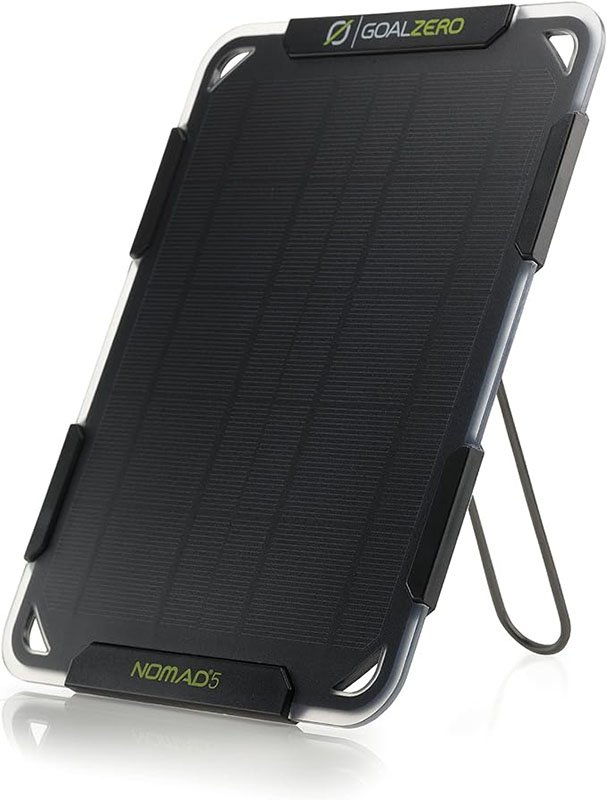
For the best budget, we picked the Goal Zero Nomad 5 because you get an ultra-compact solar charger with very few complaints for its low price tag.
Although its power output is only 5 watts, which is fine for a cell phone or headlamp, the Goal Zero Nomad’s biggest selling point is the price and its compactness. Plus, it’s a part of a long line of Goal Zero Nomad products.
In terms of length and width, it’s smaller than a sheet of printer paper and it weighs less than a pound. You stand it up with a built-in kickstand. And while it has a USB port, it comes with a battery, which you can use to charge other electronic devices.
Features & Specs:
- Power Output: 5 watts
- Dimensions: 9.45 x 7.01 x 1.1 inches
- Weight: 12.7 ounces
Best Value: X-Dragon 20W
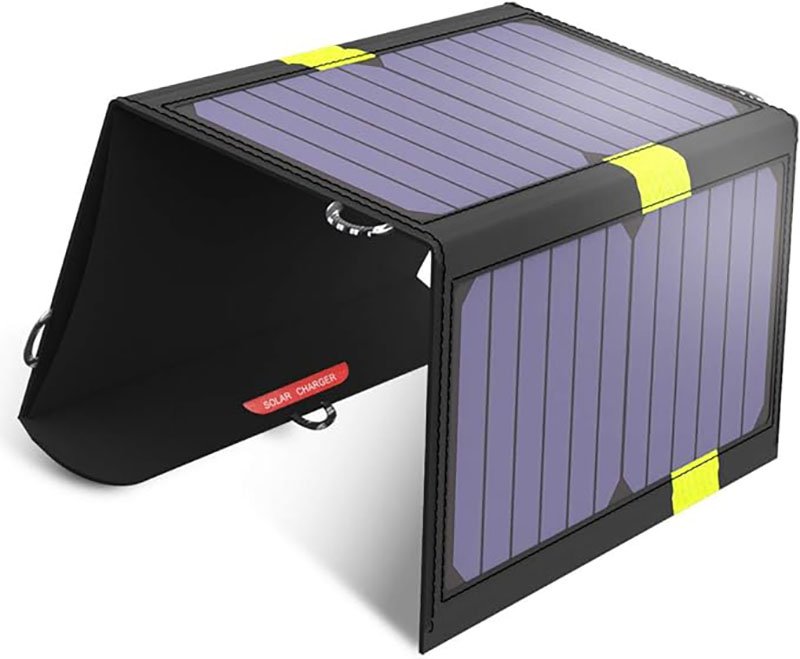
For the best value, we picked the X-Dragon 20W because, for about $100, you get an extremely durable and fast-charging solar panel. On paper, there’s a lot to like about the X-Dragon, too.
In addition to a 20-watt power output, the X-Dragon 20W features waterproof construction and a USB-A port. Folded up, it’s a little bit bigger than a sheet of paper and it weighs just over a pound.
Although there are disputes about the power output — there are always disputes about power output — the main reason it’s listed as the best value and not the best overall is availability. It’s not always conveniently listed in places like Amazon.
Features & Specs:
- Power Output: 20 watts
- Dimensions (folded): 12.1 x 7.2 x 0.51 inches
- Weight: 1.34 pounds
Most Durable: SunJack 25W
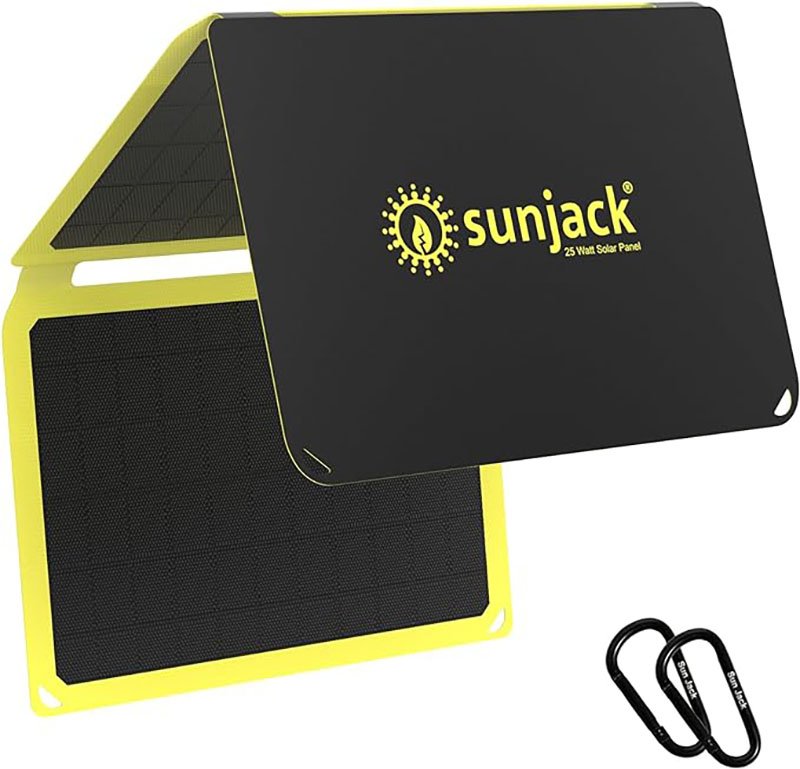
For the most durable, we picked the SunJack 25W because it’s proven to be just as tough as advertised. The case is built out of Ethylene Tetrafluoroethylene (ETFE) plastic and it’s rated to be waterproof, dustproof, and shockproof.
In marketing materials, SunJack describes its solar panels as built to withstand disasters like hurricanes and floods. While we’re unclear if people have used it during emergencies, most people praise its durability. Plus, it has a USB C and USB A port.
The main criticism is that the SunJack 25W solar panel is a little heavy at 1.7 pounds and awkward to fold up.
Features & Specs:
- Power Output: 25 watts
- Dimensions (folded): 11 x 7.8 x 1 inches
- Weight: 1.7 pounds
Best in Tight Spaces: BioLite Solar Panel 5
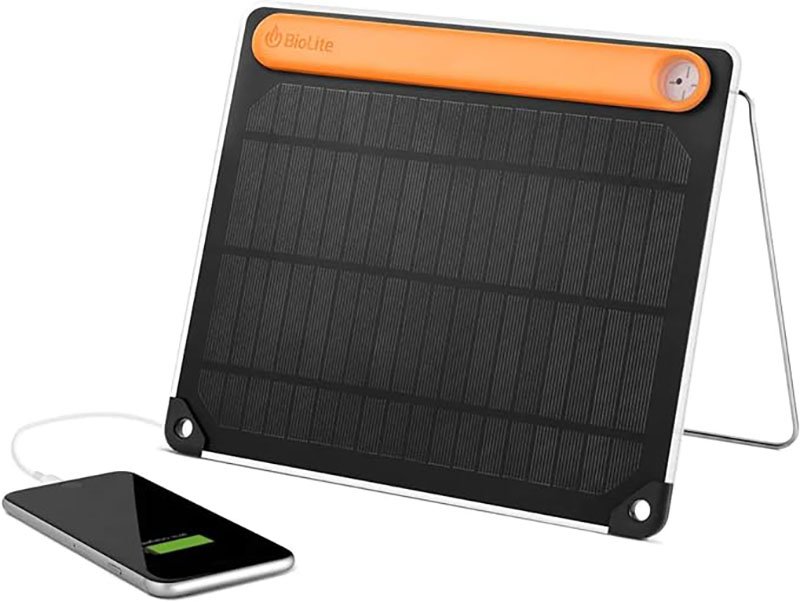
For the best in tight spaces, we picked the BioLite Solar Panel 5. Although it’s comparable to the Goal Zero Nomad 5, the BioLite Solar Panel is equipped with a sundial and a 360-degree built-in kickstand so you can always keep it perfectly angled toward the sun.
The solar panel is also a little smaller than a sheet of paper, just less than 1 inch thick, and weighs less than a pound. It also has a built-in battery bank as a USB port.
The main criticism is that it’s not the fastest charging, but it’s also really small. But again, it’s got the battery bank.
Features & Specs:
- Power Output: 5 watts
- Dimensions (folded): 10.12 x 8.19 x .94 inches
- Weight: 13.76 ounces
Best Solar Efficiency: BigBlue SolarPowa
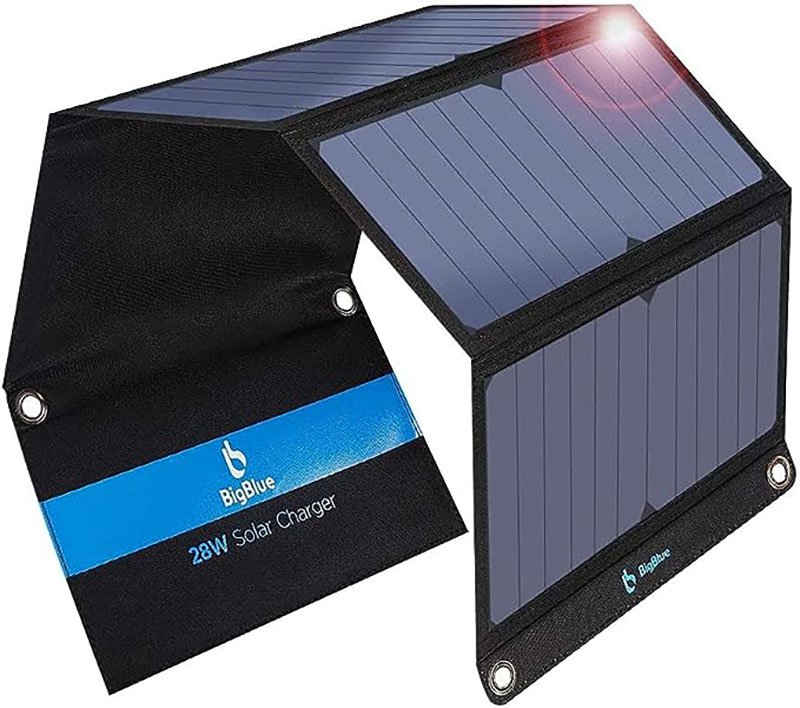
For the best solar efficiency, we picked BigBlue SolarPowa because it’s been described as a “super speedy charger” with a relatively high power output for a portable solar panel.
Reviewers found that the BigBlue SolarPowa charges well under direct sunlight and indirectly as well. Plus, it has three USB ports and it’s compatible with both iPhones and Android chargers.
Unlike others on this list, the BigBlue solar panel doesn’t have a built-in kickstand, but you can conveniently fold and position it however you need to.
Features & Specs:
- Power Output: 28 watts
- Dimensions (folded): 11.1 x 6.3 x 0.2 inches
- Weight: 1.48 pounds
Things to consider before buying solar panels for camping
How Solar Panels Work
The oversimplified answer to the question “How do solar panels work?” is that when they’re placed under direct sunlight, they absorb the light and then convert it into electricity. For a more detailed answer, we look to the federal Office of Energy Efficiency & Renewable Energy.
On its website, the office explains that the technology is called photovoltaics, or PV for short.
The way it works is that the sunlight — or energy called photons — will collide with a semiconductor on a solar panel, which contains cells made up of a positive and negative layer. Then, the cell will collect electrons from the photon.
Since a solar panel consists of multiple cells, it can pull lots of electrons from the photon and generate an electrical current. With more panels comes more cells and more electricity. For portable solar panels, what happens with that electricity depends on what you plug into it.
Most people either charge their electronic devices directly or store the energy in a power bank.
Types of solar panels for camping
According to the federal government, silicon is the most common material used to make solar cells. About 95% of all solar panels sold are made out of the material.
The reason is silicon is one of the most abundant elements on earth, which means it’s inexpensive, but it is also durable and has a high conversion efficiency, so it allows more sunlight to become electricity.
With that said, most solar panels are constructed out of either monocrystalline or polycrystalline silicon.
The difference between the two boils down to how they’re made. The former requires a longer and more involved process, resulting in a slightly more expensive yet more efficient product. Therefore, most portable solar panels use monocrystalline silicon.
Key Features of Portable Solar Panels
Power Output
The power output refers to the amount of power that the solar panel can generate in an hour. That power is measured in watts. For a portable camping solar panel, the power output is relatively low, oftentimes 100 watts or less, but they’re adequate for charging small devices like a cell phone or laptop.
If you want to charge large appliances like a refrigerator, you’ll need a larger portable solar panel capable of producing a power output of at least 100 watts. More often than not, more or larger panels collect more power, but they’re also heavier and bulkier.
USB Ports
Most portable solar panels connect to electronic devices through a USB port. However, USB ports come in a variety of sizes, such as USB A or USB C, so you’ll need to make sure your cord and the port are compatible.
Additionally, the number of USB ports varies by solar panel. However, the number of ports typically depends on the panel’s power output.
External Battery
Most portable camping solar panels are designed to pair with an external battery, or power bank, which you can use to charge your electronic devices. While one is designed to convert sunlight into electricity, the other is designed to store electricity.
FAQs about Portable Solar Panels
Are solar panels affected by clouds?
Yes, but not as much as you’d think. While they work best under direct sunlight, solar panels will continue to convert light into electricity during cloudy or rainy days. However, power output under those conditions depends on the amount of available light and the quality of the solar pane.
How much solar power do I need for camping?
How much power you need depends on how many electronic devices you need to charge and their energy consumption. If you only need to charge a cell phone, you’ll easily get by with 10 watts. But if you’re car camping with a fridge, lights, water pump, and other electronic devices, you’ll need at least 100 watts.
What’s the difference between a portable solar panel and a portable power station?
Function. You use portable solar panels to convert sunlight into electricity while you use portable power stations to store that electricity. In other words, you’d use a portable power station — or power bank — as a battery to charge your electronics as needed.
How We Tested
For this guide, we started by considering multiple solar panels. We considered portable solar panels for backpacking as well as car camping and overlanding, but we ultimately decided to focus primarily on small portable ones specifically for backpacking and camping, which narrowed our selection significantly.
With that said the people who we decided to write for will be the ones who venture out into the wilderness with several low-powered electronic devices, such as cell phones or camera equipment. These are people who will need to charge devices regularly but they won’t need a ton of electricity.
Next, we collected data from multiple sources, including other buyer’s guides, review websites, vlogs, and user reviews listed on e-commerce websites. We looked for options that had overall positive reviews and excluded options with overall negative reviews.
The Best Portable Solar Panels
If you’re looking for the best solar panel for camping, we recommend the Anker Solix PS30 Solar Panel. It’s durable and fast charging.
If 30 watts is too much and you want something less expensive, the Goal Zero Nomad 5 is a great option. While we say the SunJack 25W is a great in-between option, it might be hard to find, so yet another option is the BigBlue SolarPowa.






